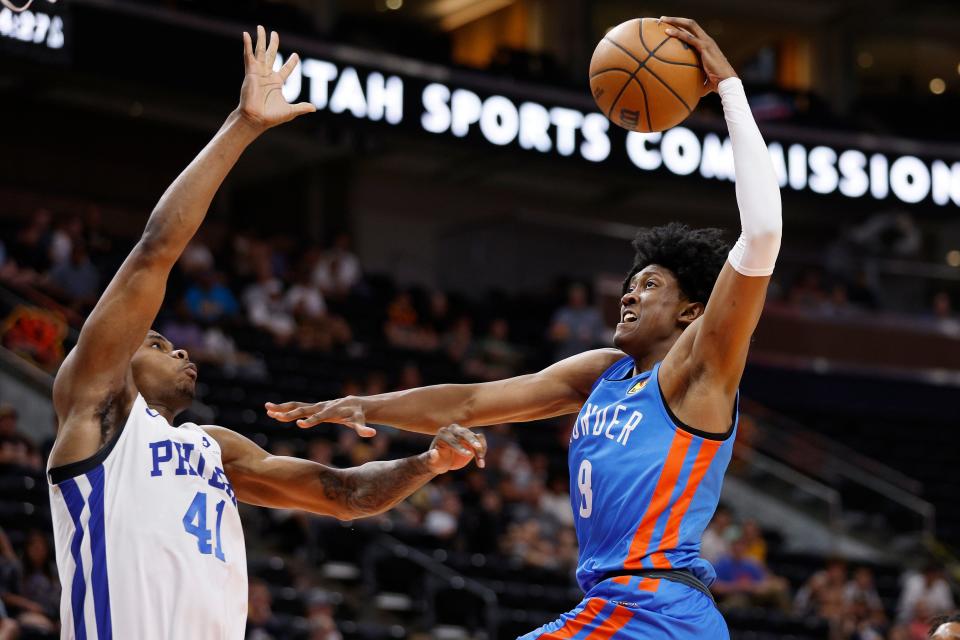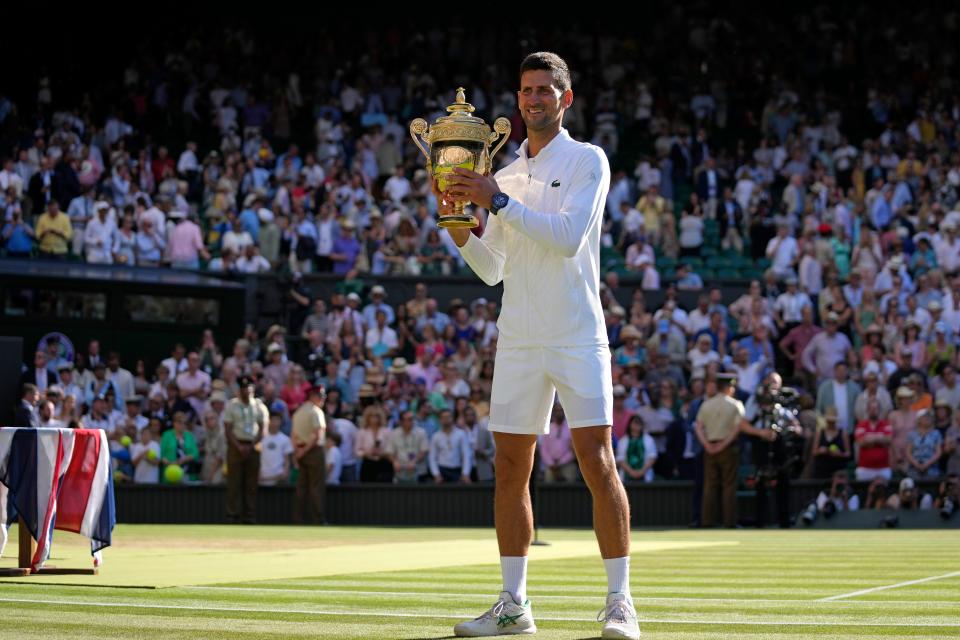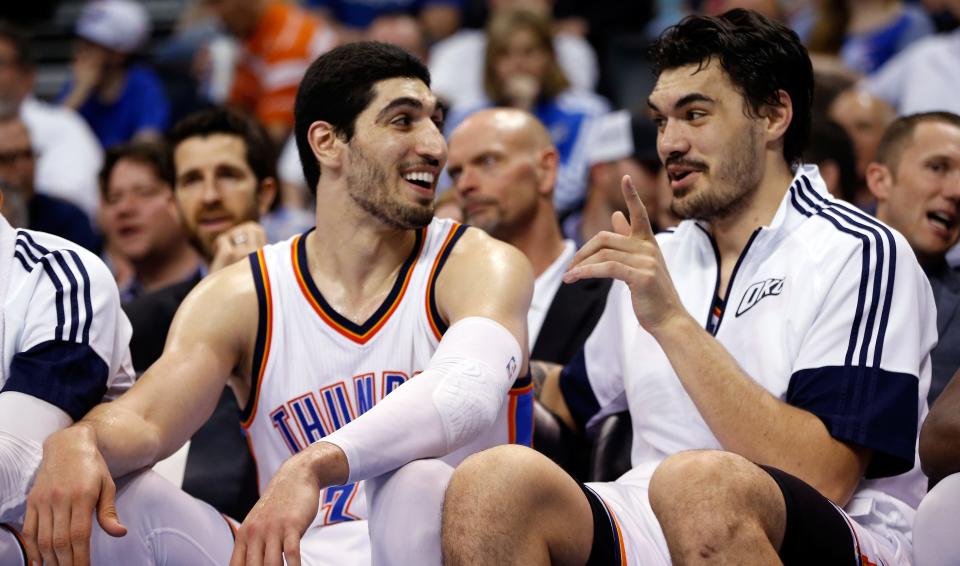Tramel's ScissorTales: OU football still seeks first all-American of Lincoln Riley era
- Oops!Something went wrong.Please try again later.
- Oops!Something went wrong.Please try again later.
- Oops!Something went wrong.Please try again later.
- Oops!Something went wrong.Please try again later.
- Oops!Something went wrong.Please try again later.
- Oops!Something went wrong.Please try again later.
CeeDee Lamb signed with OU football in February 2017. That autumn, Lamb was playing for the Sooners. Even caught six passes in the national semifinals against Georgia.
Lamb was a great player. And in 2019, Lamb was named first-team all-American.
No big deal, really. Great player at a great program. Lamb was the 39th Sooner of the 21st century to make first-team all-American; all but Rocky Calmus, Jeff Ferguson and J.T. Thatcher were recruited by Bob Stoops staffs.
Stoops retired in June 2017, Lincoln Riley immediately was named Stoops’ successor and the Sooners continued to roll. Great teams. Great games. Great players.
But now Riley is gone to Southern Cal, and OU still is waiting for one of the recruits from his classes to make first-team all-American.
That’s right. OU has not had a Riley-recruited all-American.
Tramel:Did Lincoln Riley find harder road in the Big Ten with USC than in SEC with OU?
![CeeDee Lamb wore No. 2 at OU, but he'll join the famed No. 88 club with the Dallas Cowboys. [Bryan Terry/The Oklahoman]](https://s.yimg.com/ny/api/res/1.2/iIcS8JDRgdx2Hv3kGvsz5A--/YXBwaWQ9aGlnaGxhbmRlcjt3PTk2MDtoPTY0MA--/https://media.zenfs.com/en/the-oklahoman/621af3302d67924ddb60ed23e5a5db67)
That’s Riley as head coach. Kyler Murray, who in 2018 quarterbacked as well as anyone ever has in crimson and cream, came to Norman in 2016, primarily because of Riley, who then was Stoops’ offensive coordinator. Murray won the 2018 Heisman Trophy and indeed made all-American.
So this is no knock on Riley’s status as a quarterback whisperer. Even down to Caleb Williams, who in January followed Riley to USC, Riley brought in elite quarterbacks.
But the rest of the roster hasn’t seemed to flourish as much, a point I made last week when only one Sooner, punter Michael Turk, showed up on the preseason all-Big 12 team.
It wasn’t so much the lack of heralded Sooners, it was the lack of Sooner candidates. No one stood in the gap as an overlooked all-Big 12 player.
And the gradual talent slide is apparent. None of Riley’s four recruiting classes as head coach – 2018, 2019, 2020 and 2021 – have produced a first-team all-American.
Lamb made all-American in 2019. The 2018 all-Americans were Murray, Marquise Brown and Ben Powers, all signed under the Stoops regime.
Not since 1996-99 has OU gone two straight seasons without a first-team all-American. The only Stoops years without a first-team all-American was 2005, 2012 and 2014.
Stoops seemed to rally whenever a talent deficiency arose. By 2008, OU had four first-team all-Americans – Sam Bradford, Duke Robinson, Jermaine Gresham and Gerald McCoy. By 2017, OU had four more – Baker Mayfield, Orlando Brown, Mark Andrews and Obo Okoronkwo.
But now, with Brent Venables taking over as head coach, the Sooners face a potential third straight season without a first-team all-American.
The talent slide has resulted in two straight seasons in which OU failed to finish atop the Big 12 standings. The Sooners beat Iowa State in the 2020 Big 12 Championship Game but didn’t so much as make the Big 12 title game in 2021.
OU is headed for the Southeastern Conference sometime between now and 2025. The plan was to build up the program and be ready for the SEC rigors when the move took place. That’s still the plan.
But the Sooners suddenly are scrambling to keep pace in the Big 12, much less the SEC.
More:Why OKC Thunder's Josh Giddey 'secretly' wanted to play with Chet Holmgren
Giddey-Holmgren should play together
Josh Giddey says he secretly wanted the Thunder to draft Chet Holmgren. Giddey wanted to play with the 7-foot-1 Gonzaga phenom.
Giddey got his wish – the Thunder picked Holmgren second overall. And Giddey will get his wish even more. Giddey and Holmgren figure to be on the court together much of the time in the 2022-23 season.
Their shooting might dictate such a rotation.
The Thunder is four games into its 2022 Summer League experience, and while we have Holmgren headed to the Basketball Hall of Fame and Santa Clara Jalen Williams headed to the Thunder starting lineup, you never know.
Summer League is often fun and sometimes insightful, but it’s no great indicator of the future.
I mean, we didn’t need Summer League to know Holmgren is a prospect extraordinaire.
But some things do translate. And shooting is foremost on that list.
The Thunder has been quite the poor shooting team for several years. Has anything in Summer League been a sign that things could change?
Yes.
There are two basic shooting statistics – 3-point percentage and foul shooting percentage. Players who are a little rough from 3-point range can become better long-range shooters. But players who struggle from the foul line rarely develop into quality 3-point shooters.
So here’s what I’ve learned. Holmgren’s shooting chops are legit. Giddey’s shooting troubles continue.
Holmgren has made five of 13 3-point shots, 38.5 percent. Impressive. Even more encouraging, Holmgren is 15 of 15 from the foul line. His shooting touch was not overhyped.
But Giddey’s shooting woes continue. The 20-year-old sophomore is a wondrous player, and his Summer League theatrics have wowed the NBA. Just not his shooting.
Giddey as a rookie shot 26.3 percent from 3-point range and 70.9 percent from the foul line. Both well below acceptable for most NBA guards.
In four Summer League games, Giddey has made nine of 15 foul shots (60 percent) and one of 12 3-pointers (8.3 percent). Both well below acceptable for most seventh-grade guards.
So optimism is tempered for dramatic shooting improvement from Giddey. He’s still considered a potential star. Great passer. Excellent rebounder. Good floor leader. Just can’t shoot.
You can win with guys that can’t shoot. But you can’t win with many.
In the modern NBA, few quality teams field a lineup with more than one poor shooter.
Which brings us back to Holmgren and Giddey. Holmgren is a great fit with Giddey, because the big guy makes up for Giddey’s shortcomings.
Seems natural that Mark Daigneault would pair Giddey with Holmgren. When the Thunder goes with Darius Bazley or Derrick Favors or whoever at center, Daigneault can sub out Giddey with a perimeter player with a better shot.
As for other Thunder shooting in Summer League, here’s what we’ve seen so.
NBA Summer League:Chet Holmgren, Jalen Williams shine as Thunder rolls past Grizzlies

Santa Clara Williams: 4-of-7 on 3-pointers, 7-of-11 on foul shots. A conundrum. Excellent 3-point shooting, shaky foul shooting. In three years of college, Williams made 35.2 percent of his deep ball, but 39.6 percent last season. And Williams was an excellent foul shooter at Santa Clara, making 78.5 percent over three years.
Aaron Wiggins: Wiggins has made his only foul shot in Summer League but is 5-of-6 on 3-pointers. Five of six. That’s probably an anomaly. Wiggins shot 30.4 percent from deep last season. But he was a 36.3 percent 3-point shooter (solid) and a 72.9 percent foul shooter at Maryland (not solid). So who knows?
Aleksej Pokusevski: Poku has made four of 12 3-pointers in Summer League, which is better than his 28.5 percent over two NBA seasons. Poku hasn’t been a good foul shooter with the Thunder, 71.7 percent, but is six of seven in Summer League. I’m not optimistic.
Tre Mann: Mann is a ghastly 1-of-10 from 3-point range in Summer League but made 36 percent last season as a Thunder rookie, so don’t get too discouraged. Mann is 10-of-11 from the foul line. He was a 79.3-percent foul shooter last season.
Jeremiah Robinson-Earl: JRE has made just 2-of-9 from 3-point range in Summer League but was an encouraging 35.2 percent in his rookie season. JRE is 4-of-4 from the foul line but was just 74.1 percent as a rookie.
Lindy Waters III: Waters has made 4-of-10 from 3-point range, after making 36.3 percent as a Thunder rookie. Waters has made 5-of-6 from the foul line in summer; he shot 80 percent with OKC last season.
Ousmane Dieng: The first-round draft pick is shooting frequently and making infrequently, 4-of-23 from 3-point range. He was billed as a project on outside shots, and there’s no holes in that theory. Dieng has made four of seven foul shots.
Eugene Omoruyi: The 6-foot-7 forward who signed a two-league contract with the Thunder has made 6-of-8 on foul shots and 1-of-4 from 3-point range in Summer League. In college at Rutgers and Oregon, Omoruyi made 32.4 percent of his deep balls and 67.4 percent of his foul shots. So no great promise as a shooter.
Barr for Oklahoma Sports Hall of Fame?
George Barr is not a name you know. Even for hard-core sports fans in Oklahoma.
But Richard Hendricks, who runs the Territorial Capital Sports Museum in Guthrie, believes Barr is worthy of induction into the Oklahoma Sports Hall of Fame. And Hendricks is right.
Barr was a 19-year National League umpire who founded the nation’s first umpiring school and became a pioneer in turning out quality baseball arbiters.
Barr worked the 1937 All-Star Game, when a line drive famously injured Dizzy Dean’s toe, for all intents and purposes ending Dean’s career. Barr worked the second of Johnny Vander Meer’s consecutive no-hitters in 1938, a feat that’s never otherwise been accomplished and isn’t likely to be repeated. Barr worked Gabby Harnett’s “Homer in the gloamin’” game that virtually won the 1938 pennant for the Cubs.
Barr worked home plate in Babe Ruth’s final game, in 1935.
Barr, who died in Sulphur in 1974 at age 82, was born on July 19, 1892 in Scammon, Kansas. According to the Associated Press, Barr arrived in Tulsa in 1915 “with two nickels to his name … enough for a shoeshine and a Sporting News.”
Barr eventually went to work at McNulty Park, Tulsa’s minor-league baseball stadium. In 1923, Barr was head usher when an umpire failed to make it to a game. Barr was summoned, and a career was launched.
By 1931, Barr was in the National League.
Colleagues called him the Ice Man of Baseball, after an irate fan accosted him on the field with an ice pick.
Barr became known as a cool handler of players and managers who complained.
Leo “Durocher and I had more trouble until he was smart enough to know how much I would tolerate,” Barr told the AP.
Barr pioneered the use of the inside chest protector.
In 1935, Barr founded an umpiring school in Hot Springs, Arkansas. That school eventually moved to Florida and later toured all over the world, training young umps.
Barr retired in 1950, having worked four World Series and two all-star games. He later was president of two minor leagues, the Western Association and the KOM League. Barr remained a Tulsa resident most of his life.
Hendricks’ Territorial Capital Sports Museum has a collection of Barr artifacts.
The New York Historical Society Museum and Library said of Barr: “Few men have contributed as much conceptually to major league umpiring as George McKinley Barr.”
Hendricks is on to something. George Barr is worthy of induction into the Oklahoma Sports Hall of Fame.
'Pinch-me moment':OU softball surprised Alex Storako, but here's why she is now a Sooner

The List: Men’s tennis major champions
Novak Djokovic’s Wimbledon championship Sunday continued the incredible dominance of three men in tennis.
Rafael Nadal, Djokovic and Roger Federer have combined to win 63 of the last 76 major tournaments. That means the rest of the world’s four billion males have combined for 13.
Not that long ago, 2002, Pete Sampras won his 14th major title, the U.S. Open, and appeared to have set a record that could stand for a century. In two decades, not only was Sampras surpassed by three players, all three have virtually lapped him.
Not only have Nadal, Djokovic and Federer dominated tennis, their domination has grown as they reach the age when great champions decline rapidly. Djokovic is the youngest of the group, at age 35. The trio has won 20 of the last 22 majors, with only the U.S. Open a thorn in its side – Dominic Thiem won in Flushing in 2020 and Daniil Medvedev in 2021.
Here are the players with the most major tennis titles:
1. Rafael Nadal 22: Nadal is still winning. He won the Australian and French Opens this year.
2. Novak Djokovic 21: Djokovic might be ahead of Nadal, except he was expelled from Australian before the Aussie Open in January for not having the Covid vaccine.
3. Roger Federer 20: Now 40, Federer got this dynasty started with a Wimbledon title in 2003 but hasn’t won a major since the 2018 Australian.
4. Pete Sampras 14: Sampras’ titles came from 1990-2002, which at the time seemed like a long run.
5. Roy Emerson 12: Emerson’s titles came from 1961-67, when many of the great players were ineligible due to professionalism.
6. Bjorn Borg 11: The biggest winner of tennis’ golden age (1970s-80s). Borg’s titles came from 1974-81.
6. Rod Laver 11: Laver won six titles from 1960-62, then won five more from 1968-69, when the open era arrived and pros were welcome. Had Laver played in those five years worth of majors, he could have reached 20 titles.
8. Bill Tilden 10: Tilden helped make tennis a mainstream sport by becoming a star from 1920-30, when he won his titles.
9. Andre Aggasi 8: Agassi was a worthy challenger to Father time, winning his titles from 1992-2003.
9. Jimmy Connors 8: An unabashed star of the 1970s, Connors won majors from 1974-83.
9. Ivan Lendl 8: Probably the best player from the 1980s, Lendl won majors from 1984-90.
9. Fred Perry 8: The Brit won his majors over a 13-tournament span, 1933-36.
9. Ken Rosewall 8: Joins with Laver in staking claim to the greatest tennis player of all time. Rosewall won four majors from 1953-56, turned pro in 1958 and spent a decade away from the majors. He returned for the open era and won four more majors, the final coming in the 1972 Australian, at age 37.
Tramel's ScissorTales:OKC Thunder rookie Chet Holmgren adds another reason for optimism

Mailbag: Sam Presti’s tall, white guys
Some readers like to find tendencies in the Sam Presti draft picks. Here’s a strange one.
Edwin: “Since arriving in OKC, Presti has been ga-ga for 7-footish white guys. He hit on Adams. The others, not so much.”
Tramel: Edwin is right, that Presti has had a decent number of tall white guys. But I disagree on how many hits. Several have excellent additions to the roster.
Domantas Sabonis, Enes Kanter, Nenad Krstic, Nick Collison. They all helped Thunder win big. Well, Sabonis played quite well as a rookie, then helped the Thunder keep winning by being bait for the Paul George trade.
Even today, Mike Muscala is a valuable hand.
Sure, the Thunder has taken a flier on players like Aleksej Pokusevski, Joffrey Lauvergne, Mitch McGary, Byron Mullens, Cole Aldrich, Steven Hill and Robert Swift. But that's true of every franchise.
Every team has washouts of every size, every color, every nationality. When you’re not picking in the top 10, you have to draft about three guys to find one keeper.
Berry Tramel: Berry can be reached at 405-760-8080 or at btramel@oklahoman.com. He can be heard Monday through Friday from 4:40-5:20 p.m. on The Sports Animal radio network, including FM-98.1. Support his work and that of other Oklahoman journalists by purchasing a digital subscription today.
This article originally appeared on Oklahoman: OU football still seeks first Lincoln Riley-recruited all-American

